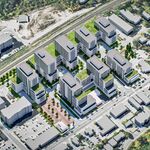Improve the reliability of the system through grade separation and automation can save much more time than whatever stated from the "average speed". If the train is automated, then the timing of the trains are very predictable. It is almost guaranteed to have a train at a specific location at a specific time.. well, unless TTC screw up again. If you are riding the train for an important appointment or job that you have to arrive on time, you do not care about the "average travel time" - you only care about the "maximum travel time", or at least, the 95th-98th percentile so that you will not be late unless you're very unlucky.
When I was commuting on SkyTrain in Vancouver for a year, I had to transfer from the train to a *hourly* bus route. But I know the automated train is very reliable, so I am able to set up my connection as tight as possible - 1 minute to enter the station and board the train, and 1.5 minute for the connection to the hourly bus route. So the total wait and connection time is only 2.5 minutes. I do this trip almost every weekday for almost a year, and I only missed the connection for a grand total of 3 times. Now, if the system is somewhat less reliable, how much time should I add for the wait transfer so I won't get home one hour late everyday? If I have to add 7.5 minutes for the wait of train and possible gap between trains, and another 7.5 minutes from the possible delay in the trip, then the saving from grade separation and automation is not just 5 minutes, it is 20 minutes.




